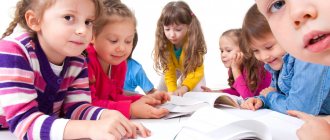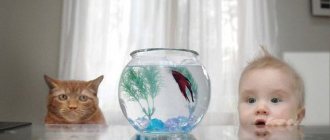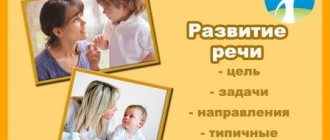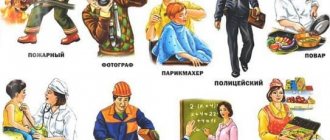Ways to unite children at work
Plan
The purpose and objectives of labor activity in a preschool educational institution
Types of work activities of preschoolers
Forms of organization of preschool children
Ways to unite children at work
1. The purpose and objectives of labor activity in a preschool educational institution
The purpose of work in a preschool educational institution is the moral, psychological and practical preparation of children for conscientious work for the common benefit and the formation of the principles of hard work. In kindergarten, this goal is achieved in accordance with the age capabilities of the children, as well as the characteristics of their work activities.
Tasks of labor activity of preschool children:
1. Fostering a positive attitude towards the work of adults, the desire to provide them with all possible assistance.
2. Formation of labor skills and their further improvement, gradual expansion of the content of work activity.
3. Raising positive personal qualities in children: habits of work effort, responsibility, caring, thrift, readiness to take part in work.
4. Formation of skills for organizing your own and general work.
5. Nurturing positive relationships between children in the process of work - the ability to work cooperatively and amicably in a team, to help each other, to kindly evaluate the work of peers, to make comments and give advice in the correct form.
2.Types of work activities of preschoolers
According to its content, the work
preschool children
are divided into four types
(V. G. Nechaeva, G. N. Godina, D. V. Sergeeva, R. S. Bure, L. I. Zakharevich, etc.):
· self-service,
· household work,
· labor in nature,
· manual and artistic work.
SELF-CARE
- this is a constant concern for the cleanliness of the body, about the order in the suit, the willingness to do everything necessary for this without external demands, out of an internal need to observe hygienic rules.
The task of developing self-service skills is relevant at all age stages of preschool childhood.
Content
:
in younger groups
teach children to eat independently and carefully, to hold a spoon correctly, not to spill food, to bend over a plate, to dress and undress independently, to wash, to use a towel correctly, to sit at the table only with clean hands;
middle group children
can show greater independence in washing, dressing, eating, they are given the task of providing mutual assistance in dressing, helping children get dressed, putting away toys, the teacher increasingly turns to the consciousness of children;
in older preschool age
great importance is attached to long-term self-care responsibilities, they continue to teach how to take care of things: cleaning clothes, shoes, repairing toys, books, and include elementary skills in teaching children of younger groups.
Methods
: showing each work action and its sequence, detailed explanation, general reminder, check and evaluation, self-esteem, encouragement, observing the behavior of surrounding adults, looking at illustrations for books, reading works of art, watching puppet shows, etc.
In younger groups
The teacher shows how to perform actions: how to hold tights to make them comfortable to put on. The demonstration should be step-by-step, with an explanation. At first, the adult helps at every stage, and over time gradually reduces the share of his help, support, and hints. When teaching self-service, the teacher uses looking at pictures. They are useful in forming ideas about the sequence of actions.
HOUSEHOLD LABOR
— maintaining cleanliness and order in the room (group, dressing room, washroom and bedroom) and on the site, assisting adults in organizing routine processes. This work appears in elementary forms already in early preschool age, but acquires special significance in middle school.
Household work for children of younger groups
the content is helping an adult in wiping furniture, arranging toys, washing small items, etc. In the process of such work, the teacher develops in children the ability to focus attention on one activity and, with the help of an adult, to complete the task to the end (praise, positive assessment).
Children of middle and senior preschool age
capable of more varied household work and less need of adult help. Gradually, children acquire independence in this type of work. The teacher uses methods of showing, explaining, discussing the labor process and results, evaluating, and teaching individual methods of performing labor operations.
By older preschool age
Some children lose interest in this type of work. The reason is that the child has already mastered the necessary skills. Consequently, it is necessary to complicate the content of household labor by expanding the range of responsibilities or introducing a new object.
WORK IN NATURE
has a beneficial effect not only on the development of labor skills, but also on the education of moral feelings, and lays the foundations of environmental education.
In younger groups, attention
Children are attracted to plants and animals. Together with an adult and under his guidance, the child cares for living objects. Older preschoolers have much broader responsibilities.
Labor in nature has its own characteristics
: the result of labor can be a material product (vegetables grown by a child, etc.); delayed result (they sown seeds and only after some time were able to observe the result in the form of seedlings); living objects (caring attitude, special caution, responsibility); development of cognitive interests (experimenting, learning about inanimate nature, observing the growth and development of living objects, etc.)
HAND AND ARTISTIC LABOR
by its purpose it is work aimed at satisfying the aesthetic needs of a person. This work contributes to the development of imagination and creative abilities; develops small arm muscles, promotes endurance, perseverance, and the ability to finish what you start.
In younger groups
Separate elements of manual and artistic labor are emphasized, and the participation of an adult is required.
Mental work is characterized by effort aimed at achieving a result. The teacher teaches children to “think before they act,” to explain to themselves and others the course of their thoughts, to draw conclusions and conclusions, and finally, to receive satisfaction from finding a solution on their own (“I figured it out”). Mental labor must and can accompany any other type of child labor.
3. Forms of organization of preschool children
According to the organization of labor activities in preschool educational institutions, the following forms are distinguished:
· Work order
· Duty roster
· Teamwork
The choice of one form or another of organizing children’s work depends primarily on:
· age and psychophysiological capabilities of children;
· children's level of work experience;
· specific educational tasks set by the teacher organizing work activities;
· content of labor.
LABOR ORDER
- assigning a specific task to the child, which he must complete alone or with one of his peers. To assign means to oblige the child to do some kind of work related to both self-service and work for the team.
Peculiarities
: they always come from an adult, they contain a clear focus on obtaining a result, the task is specifically defined; this is the simplest form of organizing the work activity of preschool children; have special educational significance in working with children of primary preschool age, they enable the teacher to distinguish between play and work; they contain an element of demand, with the help of which the baby learns to act purposefully, to realize that he is carrying out an adult’s task; helps the teacher monitor the correctness of the work, the presence of labor skills, the child’s attitude towards the assigned task, the ability to complete the work, provide ample opportunities for individual work with children, enable educators to routinely, systematically involve children in feasible work, create a group business atmosphere. The assignments are varied in difficulty (simple, complex), nature of execution (individual or joint), time of execution (short-term, episodic, long-term).
DUTY ROSTER
- a form of organizing children’s work in which those on duty always perform work that has social significance and is necessary for the team.
Peculiarities
: this is a more complex form of organizing children’s work compared to assignments, requiring greater independence; those on duty are forced to carry out the task and cannot refuse it, do other work that is more interesting for them, or switch to a game; make it possible to develop in children a desire to work for the sake of others, to show a caring attitude towards their comrades, animals and plants, to develop the ability to help an adult, to notice where help is needed.
In the practice of preschool institutions, several types of duty are used, which are being introduced gradually:
· canteen duty
(2nd junior group),
· duty to prepare for classes
(middle group).
· Duties in the corner of nature
(senior group).
The content of the work of those on duty when moving from one group to another becomes more complicated. This is reflected in the POP DO.
COLLECTIVE WORK
- general work activity that unites all the children of the group at once (cleaning a group room or area, setting up a vegetable garden, flower garden, picking vegetables or fruits, decorating a hall or group room for a holiday).
Conditions
:
I. All children can be united only after they have acquired the necessary experience of working in a small team.
2. When organizing the collective work of children of the entire group, it is advisable to divide them into several units (up to 4), each of which is offered a common task.
3 the content of general work includes only those types of work, the skills of which children have a sufficiently good command of,
4. All children should be involved in work.
4. Ways to unite children at work:
labor nearby - used starting from the younger group; in work, everyone is independent, this allows the child to act at an individual pace, and the teacher to take into account his capabilities and establish contact with each child; the tasks of developing the necessary skills, sustained attention to the task, and the ability to bring it to the end are successfully solved;
common work is one of the types of collective work itself, in which children are united by a common task and generalization of the results of the work of all participants; for the first time can be organized in the middle group in the 2nd half of the day, takes place in all types of work, is organized as a general assignment, gives the child the opportunity to feel like a member of the team, realize the usefulness of his work, and be convinced of the team’s attitude towards him as a member of the children’s society; the significance of each individual result and its connection with others appears only after the end of the activity process itself;
joint work, its features are:
a) the presence of a number of successive stages (each child does not complete the entire task, but some part, repeats the same actions many times and each time transfers the result of his work to the next participant, who continues the work further; in this case, the children become dependent on each other from friend;
b) non-simultaneous inclusion of children in the activity process;
c) each of the proposed operations has some completeness; presents great opportunities for the formation of positive relationships between participants.
Development of labor activity in preschool age
While performing a work task, children often switched to play; it is the closeness of work to play that is another feature of children’s work activity. Therefore, when working with children, I often use group games-activities and games-exercises. I tried to establish a close relationship between the play and work activities of children. Thus, cleaning the group room together was turned into a game-activity. For example, the game-activity “Household Service”, the purpose of which is to teach children to participate in the organized work of a group of peers; be able to relate your activities to the work of others and understand that the work of the subgroup in which you work is part of the overall cause of the team; develop relationship skills, the habit of cleanliness and order; consolidate the ability to plan activities and distribute responsibilities among themselves; be able to evaluate the activities of your team and the team as a whole; teach to love physical work, to experience a feeling of satisfaction from participation in it, from the physical activity with which it is associated, from the positive result of the activity; create a healthy spirit of competition between groups; to form in children a belief in the social significance and necessity of household work. If the work took place outside, for example, when cleaning the area (from leaves, snow), she also introduced elements of the game. I suggested dividing into two teams, choosing foremen and distributing responsibilities. The deputies used objects, a truck is a box tied with a string, and a bulldozer is a rake, this does not bother anyone, dump trucks hum, bulldozers rumble. We support this playful mood by brightening up individual failures or grievances with a cheerful joke, a well-chosen proverb or poem:
“I took a broom, swept the whole area, the broom poked its nose everywhere, I followed it, did not lag behind. We invite you, come and find even a speck of dust!”
(Internet resource)
While washing toys and washing doll clothes, we carry out physical exercises. Wait a minute
"Wash"
(Imitation of movements).
We wash, wash, wash all day long. Look, arms, legs, are they tired? Are you ready to go to work again, or should you go? We rinse, rinse, rinse all day long. Look, arms, legs, are they tired? Are you ready to go back to work? We push, push, push all day long. Look, arms, legs, are they tired? Are you ready to go back to work? We hang, we hang, we hang all day long Look, your arms, your legs, are they tired? Are you ready to go back to work?
Children love to play role-playing games. For example: “Laundry”, “Dry cleaning”, “Canteen”, “Hospital”, “Emergency service”, “Fire service”, etc. During the games, it turned out that the children did not have some attributes for games. And since they love these games, they decided to make the attributes themselves. They began to think about what could be made from what. We discussed everything amicably and got to work. For example, we made candies from plasticine and candy wrappers for the role-playing game “Shop.” After this, the children themselves united more than once to make attributes of their games. Children are very interested in making toys. In their free time, they willingly, on their own initiative, make various crafts, often making them as gifts for their parents. With great interest and desire they make collective crafts (toys) to decorate a group room for the holidays.




